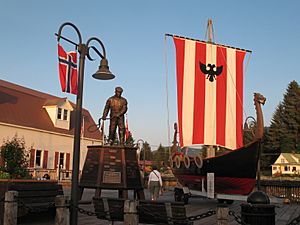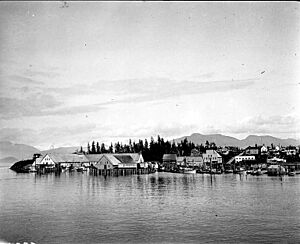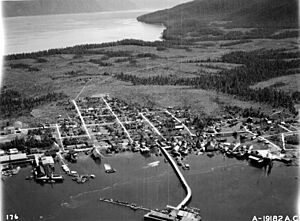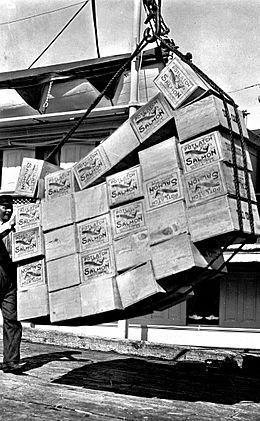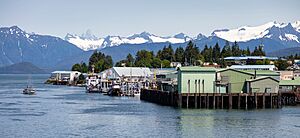Petersburg, Alaska facts for kids
Quick facts for kids
Petersburg, Alaska
|
|
|---|---|

Aerial view of Petersburg
|
|
| Motto(s):
Little Norway. Big Adventure.
|
|
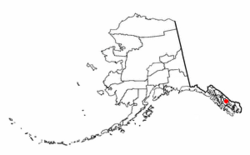
Location of Petersburg in Alaska
|
|
| Country | United States |
| State | Alaska |
| Borough | Petersburg |
| Area | |
| • Total | 46.30 sq mi (119.93 km2) |
| • Land | 44.17 sq mi (114.40 km2) |
| • Water | 2.14 sq mi (5.53 km2) |
| Population
(2020)
|
|
| • Total | 3,043 |
| • Density | 68.89/sq mi (26.60/km2) |
| ZIP code |
99833
|
| Area code | 907 |
| FIPS code | 02-60310 |
Petersburg is a special kind of town in Alaska, United States. It's called a "census-designated place" (CDP), which means it's a community that the government counts for population, but it's not officially a city. Petersburg is also the main town of the Petersburg Borough.
In 2020, about 3,043 people lived here. The borough includes Petersburg and a tiny town called Kupreanof. It also covers large areas of land that aren't lived in, all the way to the border with Canada.
Contents
Discovering Petersburg's Past
Long ago, Tlingit people from Kupreanof Island used to visit the northern part of Mitkof Island in the summer. They would set up camps to catch fish. Even older groups of people lived on the island too. Scientists have found old fish traps and rock carvings (called petroglyphs) that are about 10,000 years old!
Later, in the 1800s, a Norwegian immigrant named Peter Buschmann came to this area. He built a fish processing factory (called a cannery), a sawmill, and docks. People started calling the settlement "Petersburg" after him. It quickly grew into a busy fishing port. Ice from the nearby LeConte Glacier helped keep the fish cold.
Petersburg officially became a town on April 2, 1910. Many people from Scandinavia (like Norway) moved here. This is why Petersburg is often called "Little Norway." They even built a special meeting hall for a group called the Sons of Norway on one of the piers. More canneries were built, and they have been working ever since. As the canneries grew, Native Alaskans, like Chief John Lott, began to work and live there all year.
The Importance of Fishing in Petersburg
Fishing has always been the most important part of Petersburg's economy (how people make money). In 1965, local fishermen started a company called Icicle Seafoods. They bought the original Buschmann cannery when the fishing business was having a tough time. These fishermen and managers worked hard to make sure the fishing industry in Petersburg stayed strong. This company, now called Icicle Seafoods, helps support Petersburg and many other towns in Alaska.
In January 2013, Petersburg became a "borough." This means it joined with nearby areas to form a larger local government. The old "City of Petersburg" stopped being a separate government, but the small town of Kupreanof is still its own town within the borough.
Exploring Petersburg's Location
Petersburg is found at the northern tip of Mitkof Island. This is where the Wrangell Narrows waterway meets Frederick Sound. It's about halfway between two other big Alaskan cities: Juneau (190 kilometers or 118 miles north) and Ketchikan (180 kilometers or 112 miles south).
The United States Census Bureau says that Petersburg covers about 119.93 square kilometers (46.30 square miles) in total. Most of this area is land, and a smaller part is water.
Mitkof Island has low mountains. The flatter, lower areas are mostly covered by "muskeg." This is a type of wet, spongy ground made of plants that are slowly decaying. The island is about 20 miles long from north to south. The western side of the island is next to the Wrangell Narrows, a somewhat protected waterway for boats. Many small streams flow into the Narrows from Mitkof Island.
Petersburg is a very important fishing port. In 2011, it was the 15th busiest fishing port in the United States by the amount of fish caught. Over 101 million pounds of fish and shellfish passed through Petersburg, worth about $65 million!
Petersburg's Weather Patterns
Petersburg has an oceanic climate, which means it has mild temperatures and lots of rain, similar to coastal areas of Europe. It's also close to a subpolar oceanic climate, which is a bit colder. Petersburg has even set some Alaska state records for warm temperatures in winter months! For example, it reached 62°F (17°C) in January 1981 and 66°F (19°C) in February 1992.
| Climate data for Petersburg, Alaska (1991–2020 normals, extremes 1926–present) | |||||||||||||
|---|---|---|---|---|---|---|---|---|---|---|---|---|---|
| Month | Jan | Feb | Mar | Apr | May | Jun | Jul | Aug | Sep | Oct | Nov | Dec | Year |
| Record high °F (°C) | 65 (18) |
66 (19) |
66 (19) |
73 (23) |
79 (26) |
83 (28) |
84 (29) |
83 (28) |
81 (27) |
72 (22) |
64 (18) |
59 (15) |
84 (29) |
| Mean maximum °F (°C) | 49.8 (9.9) |
49.2 (9.6) |
51.8 (11.0) |
60.1 (15.6) |
69.8 (21.0) |
73.8 (23.2) |
74.1 (23.4) |
73.6 (23.1) |
66.3 (19.1) |
59.3 (15.2) |
50.8 (10.4) |
48.2 (9.0) |
77.4 (25.2) |
| Mean daily maximum °F (°C) | 34.6 (1.4) |
36.7 (2.6) |
40.3 (4.6) |
47.8 (8.8) |
55.3 (12.9) |
59.9 (15.5) |
61.7 (16.5) |
61.2 (16.2) |
55.7 (13.2) |
47.4 (8.6) |
39.3 (4.1) |
35.3 (1.8) |
47.9 (8.8) |
| Daily mean °F (°C) | 30.9 (−0.6) |
32.1 (0.1) |
34.9 (1.6) |
41.4 (5.2) |
48.5 (9.2) |
54.0 (12.2) |
56.3 (13.5) |
55.8 (13.2) |
50.8 (10.4) |
43.3 (6.3) |
35.8 (2.1) |
31.8 (−0.1) |
43.0 (6.1) |
| Mean daily minimum °F (°C) | 27.2 (−2.7) |
27.5 (−2.5) |
29.6 (−1.3) |
35.1 (1.7) |
41.7 (5.4) |
48.1 (8.9) |
51.0 (10.6) |
50.3 (10.2) |
45.8 (7.7) |
39.2 (4.0) |
32.3 (0.2) |
28.4 (−2.0) |
38.0 (3.3) |
| Mean minimum °F (°C) | 8.6 (−13.0) |
11.8 (−11.2) |
15.0 (−9.4) |
25.3 (−3.7) |
32.6 (0.3) |
39.9 (4.4) |
44.6 (7.0) |
42.5 (5.8) |
35.1 (1.7) |
27.2 (−2.7) |
18.2 (−7.7) |
12.5 (−10.8) |
2.9 (−16.2) |
| Record low °F (°C) | −19 (−28) |
−15 (−26) |
−6 (−21) |
10 (−12) |
21 (−6) |
29 (−2) |
37 (3) |
32 (0) |
22 (−6) |
12 (−11) |
−8 (−22) |
−10 (−23) |
−19 (−28) |
| Average precipitation inches (mm) | 11.39 (289) |
7.60 (193) |
7.60 (193) |
6.66 (169) |
5.86 (149) |
4.98 (126) |
5.63 (143) |
8.21 (209) |
14.35 (364) |
13.84 (352) |
12.28 (312) |
11.79 (299) |
110.19 (2,799) |
| Average snowfall inches (cm) | 20.7 (53) |
16.9 (43) |
20.0 (51) |
1.1 (2.8) |
0.2 (0.51) |
0.0 (0.0) |
0.0 (0.0) |
0.0 (0.0) |
0.0 (0.0) |
0.4 (1.0) |
10.8 (27) |
15.5 (39) |
85.6 (217) |
| Average extreme snow depth inches (cm) | 12.0 (30) |
11.4 (29) |
8.8 (22) |
1.1 (2.8) |
0.0 (0.0) |
0.0 (0.0) |
0.0 (0.0) |
0.0 (0.0) |
0.0 (0.0) |
0.3 (0.76) |
5.2 (13) |
10.1 (26) |
18.5 (47) |
| Average precipitation days (≥ 0.01 in) | 21.2 | 17.4 | 19.5 | 18.1 | 15.8 | 16.4 | 16.7 | 17.1 | 20.3 | 22.6 | 22.9 | 21.3 | 229.3 |
| Average snowy days | 7.1 | 7.0 | 7.3 | 1.0 | 0.1 | 0.0 | 0.0 | 0.0 | 0.0 | 0.3 | 4.9 | 8.2 | 35.9 |
| Source: NOAA | |||||||||||||
Understanding Petersburg's Population
| Historical population | |||
|---|---|---|---|
| Census | Pop. | %± | |
| 1910 | 585 | — | |
| 1920 | 879 | 50.3% | |
| 1930 | 1,252 | 42.4% | |
| 1940 | 1,323 | 5.7% | |
| 1950 | 1,619 | 22.4% | |
| 1960 | 1,502 | −7.2% | |
| 1970 | 2,042 | 36.0% | |
| 1980 | 2,821 | 38.1% | |
| 1990 | 3,207 | 13.7% | |
| 2000 | 3,224 | 0.5% | |
| 2010 | 2,948 | −8.6% | |
| 2020 | 3,043 | 3.2% | |
| source: | |||
Petersburg first appeared in the U.S. Census in 1910, the same year it became a town. When it became a borough in 2013, it was then called a "census-designated place" (CDP).
In the year 2000, there were 3,224 people living in Petersburg. There were 1,240 households (groups of people living together) and 849 families. About 38.4% of households had children under 18. The average age of people living in Petersburg was 36 years old.
Petersburg's Economic Activities
Commercial Fishing: A Key Industry
For a short time, when the commercial fishing industry was at its best, people said Petersburg had the highest income per person for a working town in the U.S.!
Commercial fishing is the most important part of Petersburg's economy. Many top fishermen earn over a million dollars from seafood each year. While there are many types of fishing, the main ones in Petersburg are done by 58-foot boats called 'seiners'. These boats catch salmon, halibut, black cod, king crab, tanner crab, and herring. Many fishermen also travel to other parts of Alaska to catch cod.
The jobs on these fishing boats can pay very well. Petersburg fishermen work hard to make sure that all seafood caught is done in a way that protects the ocean and its resources for the future. The Petersburg Vessel Owners Association helps make sure fishing is done in a sustainable way.
Many Petersburg residents also travel to Bristol Bay each summer. There, they fish for salmon on about 35 different boats.
Tourism: Welcoming Visitors
Small cruise ships (with up to 250 passengers) and private yachts visit Petersburg from May through September. Visitors come to enjoy the town's charm and natural beauty.
Culture and Fun in Petersburg
- Petersburg celebrates Norwegian Constitution Day (May 17) with a big festival called "Mayfest." It's usually a four-day party! "Little Norway" celebrates this day with more excitement than many other Norwegian-American communities. People from Petersburg have even found that their celebration is longer than the one in Norway!
- The Petersburg Marine Mammal Center is a place where you can learn about ocean animals. It also helps with research.
- The Clausen Memorial Museum, started in 1968, keeps the history of Petersburg alive. It tells the stories of the people who have lived and worked in the area.
- Petersburg is a "twin town" with Hammerfest Municipality in Norway. This means they have a special friendship and connection.
Learning in Petersburg
The Petersburg School District includes Rae C. Stedman Elementary School, Mitkof Middle School, and Petersburg High School.
Media and News
The town has one radio station, KFSK. It's owned by the community and plays public radio programs.
The Petersburg Pilot is a weekly newspaper. It started in 1974 and publishes a new paper every Thursday.
Getting Around Petersburg
Petersburg is on an island, so there are no bridges connecting it to the mainland. You can only get there by air or by sea.
Travel by Water
The Alaska Marine Highway provides ferry service to Petersburg. It's a stop on the "Inside Passage" route. Ferries travel north and south to other towns in Southeast Alaska, and even to Bellingham, Washington in the U.S. and Prince Rupert, British Columbia in Canada.
Travel by Air
Alaska Airlines offers both cargo and passenger flights to Petersburg. Flights arrive at the Petersburg James A. Johnson Airport from Wrangell and Juneau daily. These flights can connect you to Anchorage and Seattle. There are also three smaller charter air companies that operate here.
Famous People from Petersburg
- Elizabeth Peratrovich (1911-1958) was an important Alaska Native civil rights leader. She was born in Petersburg.
- Edna Jackson (born 1950), a talented artist, was also born in Petersburg.
- Bert Stedman spent a lot of his childhood living in Petersburg.
- Scott McAdams also lived in Petersburg for several years when he was a child.
- Rosita Worl, who leads the Sealaska Heritage Institute, grew up here.
See also
 In Spanish: Petersburg (Alaska) para niños
In Spanish: Petersburg (Alaska) para niños


